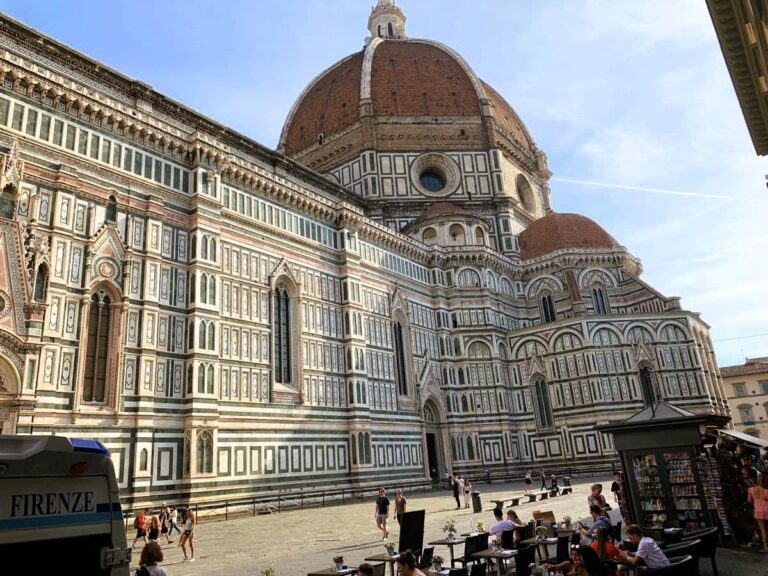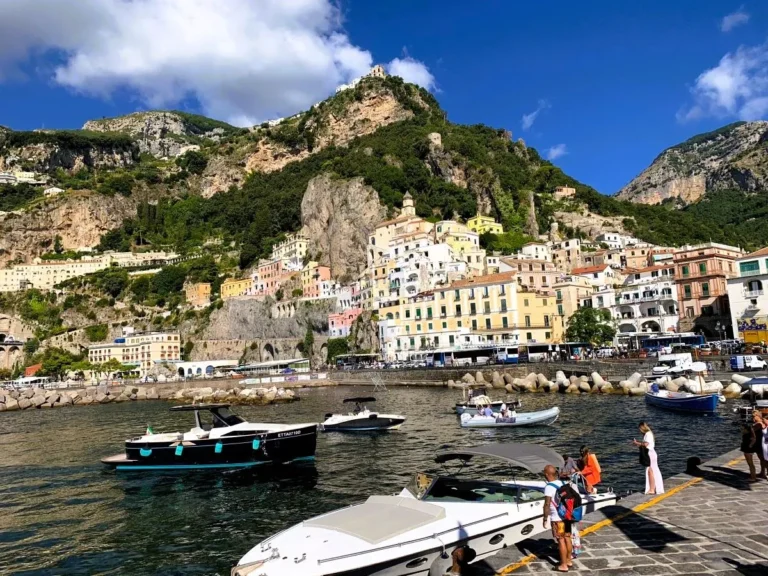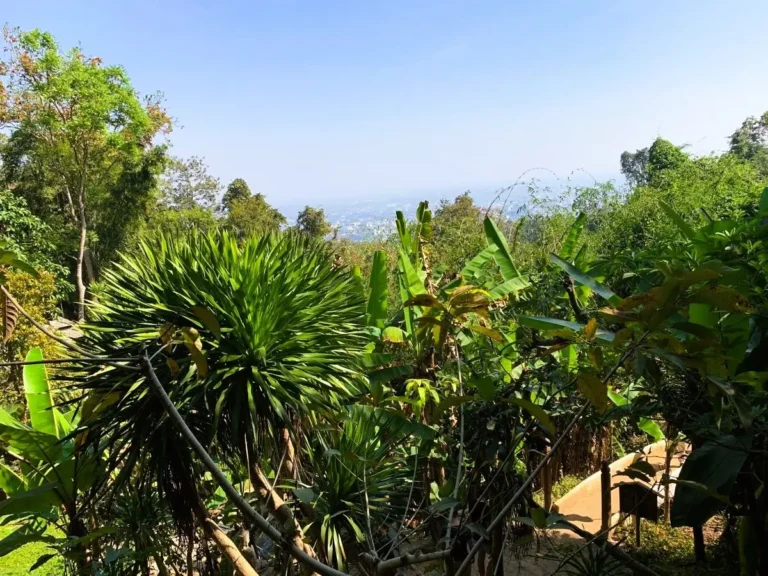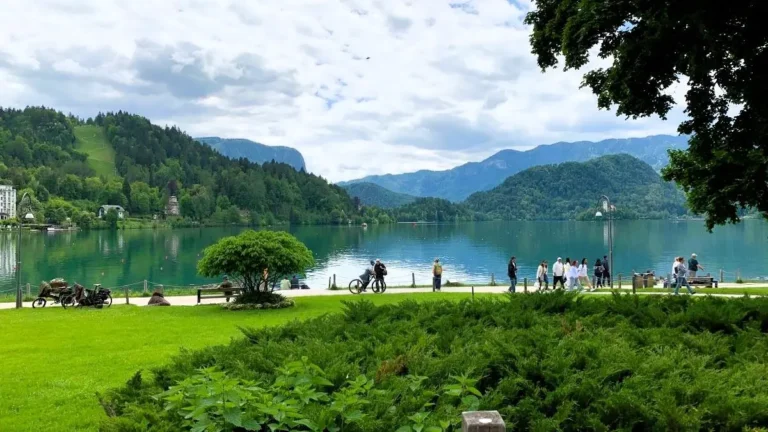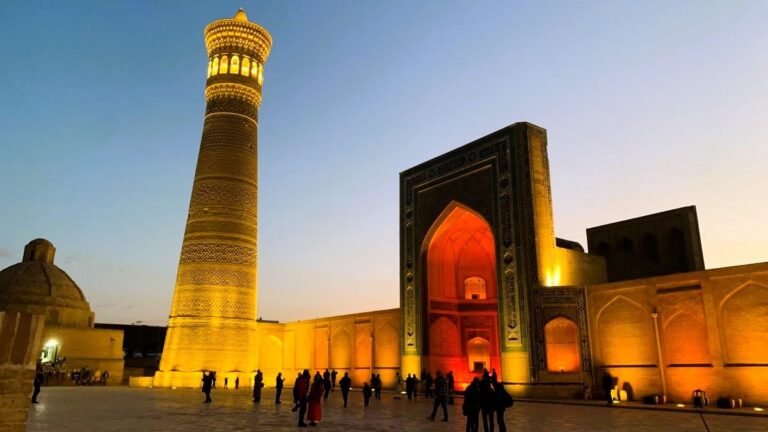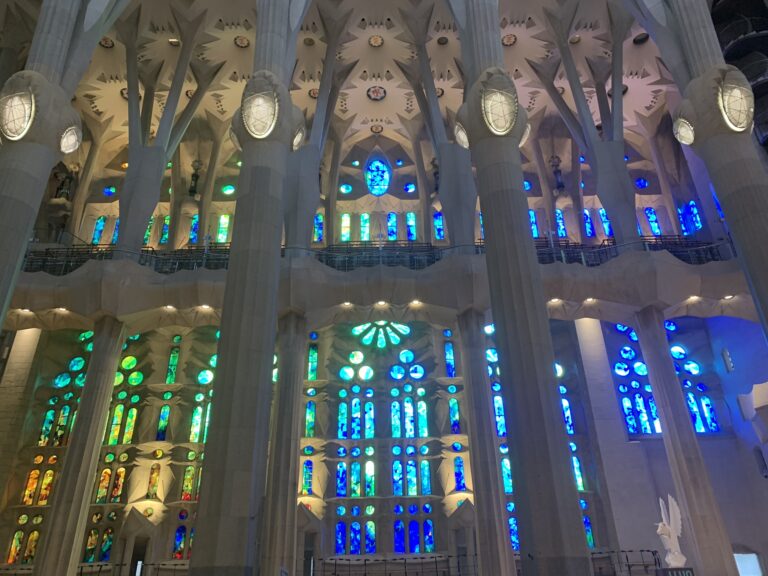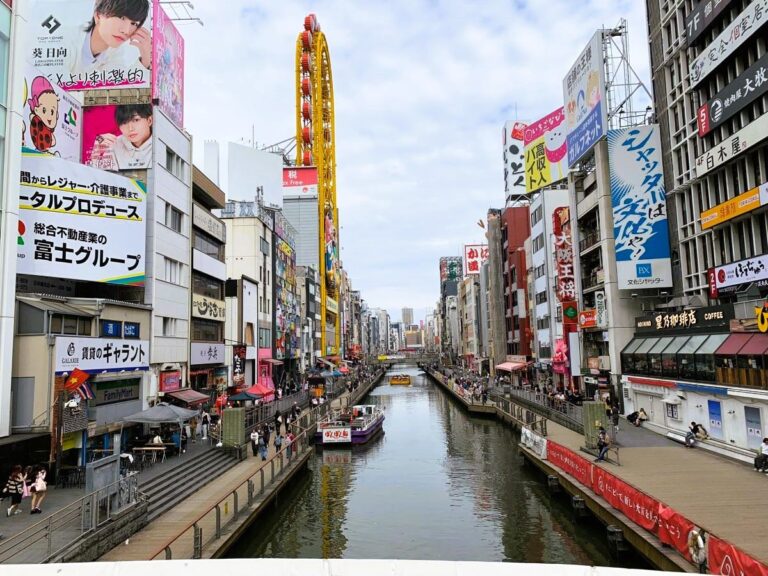Visiting Samarkand: A First-Time Traveler’s Guide to Uzbekistan’s Historic Gem
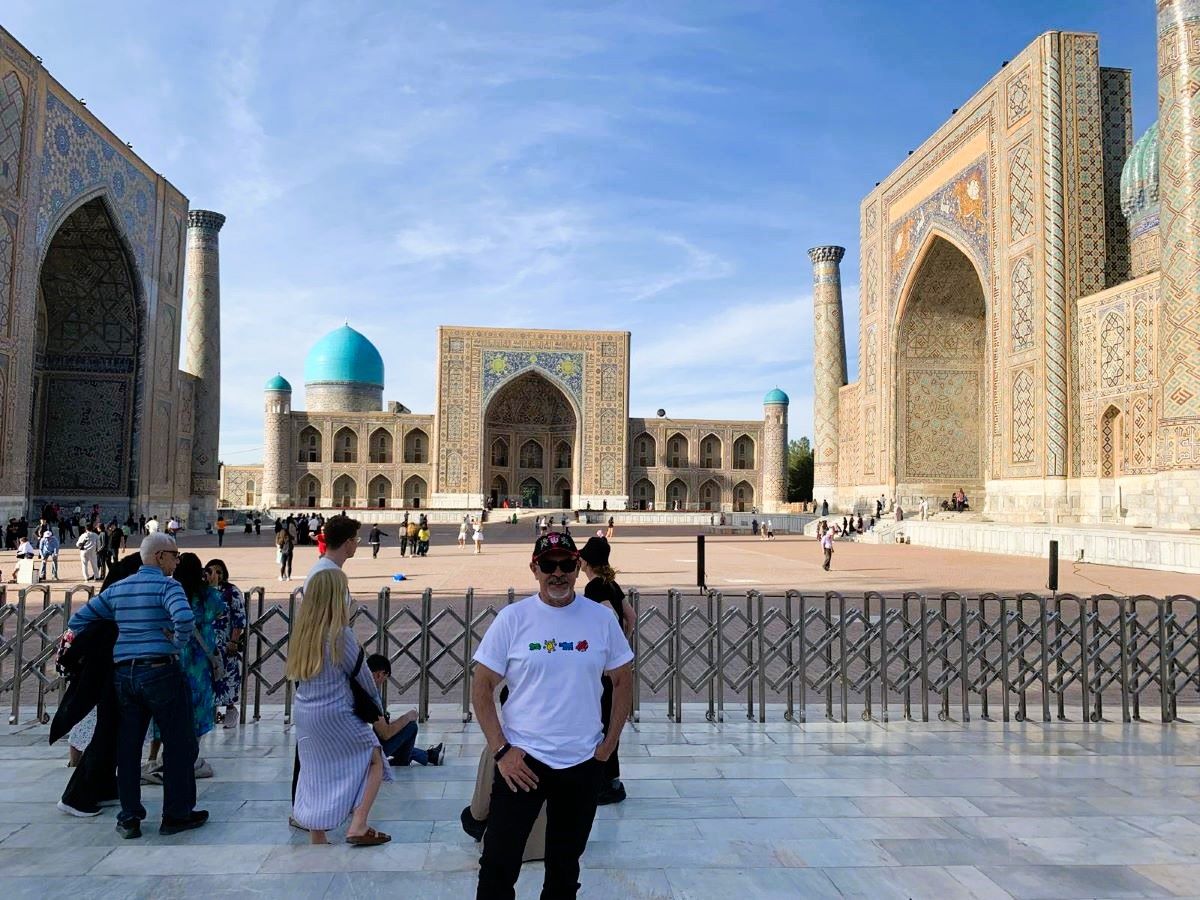
Visiting Samarkand for us was an absolute treat. We were there in October of 2024 and spent 4 lovely days exploring this beautiful city before continuing on to Bukhara.
Stepping into Samarkand, you realize you’ve stepped into a living museum. It’s a magical city!
The grandeur of Registan Square, the intricate mosaics of Shah-i-Zinda, and the serene beauty of the Bibi-Khanym Mosque were not just sights to behold—they were experiences that resonated deeply within us, and I’m sure you’ll feel the same.
This “jewel of the ancient Silk Road”, with its rich heritage and warm hospitality, transformed my understanding of Central Asia, leaving me with memories that will last a lifetime.
In this guide, I invite you to join me on a journey through Samarkand’s most iconic landmarks, share practical tips from my own travels, and offer insights to help you make the most of your visit to this historic gem.
For those visiting Samarkand for the first time, understanding its key sites and cultural depth ensures a truly immersive experience.
Hope this Samarkand travel guide will be of help.
If you need help in planning an overseas trip please check out our post: How to plan an overseas trip: 10 Essential Trip Planning Tips
Understanding Samarkand’s Historical Significance
Samarkand has been a beacon of culture and innovation for over 2,500 years. As one of the most critical hubs along the Silk Road, its history is rich, intricate, and awe-inspiring.
From its architectural marvels to its role in fostering cultural exchanges, Samarkand serves as a living chronicle of collective human achievement.
It has been a melting pot of ideas, art, and trade, leaving behind a legacy of breathtaking architecture and vibrant traditions.
The Birthplace of Timurid Architecture
Samarkand is synonymous with the Timurid architectural style, which emerged under the reign of Amir Timur (Tamerlane) in the late 14th and early 15th centuries.
This style, marked by grandeur and intricate detailing, transformed the city into a masterpiece of artistic and architectural expression.
The designs are famous for their vivid blue domes, towering structures, and geometric tile patterns that are awe-inspiring.
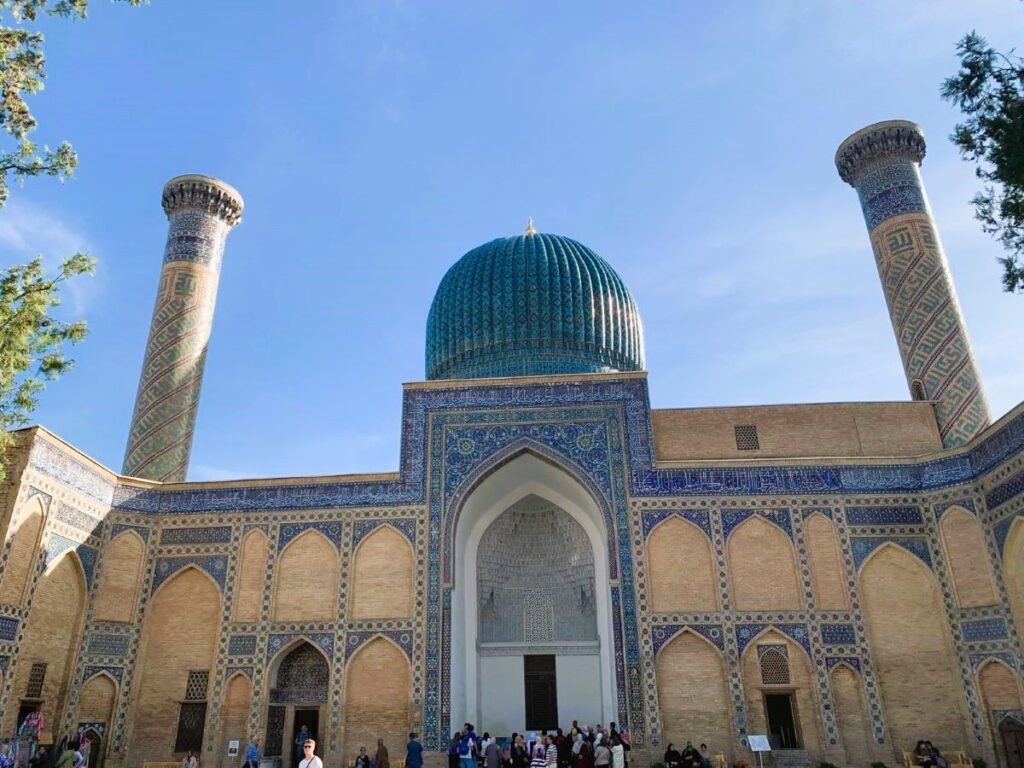
The Registan Square, a focal point of the city, showcases this style in its purest form. Its trio of madrasas, each adorned with exquisite mosaics and inscriptions, provides a glimpse into the blending of art and function in the Timurid era.
The Bibi-Khanym Mosque, another Timurid gem, stands as a testament to Timur’s ambition to make Samarkand the heart of an Islamic renaissance.
According to The Met Museum’s article on Timurid Art, the Timurid aesthetic also influenced regions as far as India and Turkey, creating a ripple effect of creativity.
Timurid architecture wasn’t just a display of wealth; it carried symbolic weight. The use of colors like turquoise and gold wasn’t random—the hues were meant to mirror the heavenly skies and paradise, blending spiritual meaning with physical space.
For further insights into this architectural brilliance, the UNESCO Timurid Highlights provide a fascinating look at the era’s enduring impact.
Cultural Melting Pot
Strategically located at the crossroads of the ancient Silk Road, Samarkand became the ultimate cultural melting pot. It was a meeting point for merchants, scholars, and artists from diverse regions—China, Persia, India, and beyond.
What made this city so unique was its openness to new ideas.
Imagine a market filled with Persian rugs, Chinese silks, and Indian spices, set against the backdrop of scholars exchanging knowledge in fields like astronomy and medicine. The diversity shaped Samarkand’s art, language, and cuisine.
According to the UNESCO Silk Road Programme, this cross-cultural exchange fostered advancements in science, technology, and the arts, cementing Samarkand’s place in global history.
Under Timur, this blend of cultures reached its peak. Samarkand became a hub for exchanging knowledge. For example, the Ulugh Beg Observatory, one of the oldest in the world, was a direct result of this cultural symbiosis. It highlights how the city turned human curiosity into lasting achievements.
In many ways, Samarkand reflects the idea that when cultures collide, something extraordinary happens. It serves as a reminder that collaboration can lead to breakthroughs, whether in art, science, or community building.
For more on its vibrant role in history, visit Samarkand: Crossroads of Cultures.
Samarkand’s unique position on the Silk Road was more than just geographical—it was symbolic. It stood as a bridge between worlds, uniting East and West in ways that continue to inspire and resonate.
How to Get to Samarkand
Here are the options:
Arriving by Train
For many travelers, the train is the most convenient and comfortable way to reach Samarkand. Uzbekistan’s high-speed Afrosiyob train connects the city with Tashkent, the capital, in just about two hours. It’s fast, clean, and affordable.
Alternatively, slower trains like the Sharq line offer a more budget-friendly option if you’re in no rush.
Tickets should be booked in advance online — just make sure to plan ahead, especially during peak travel seasons.
If you’re coming from Bukhara, another must-visit city in Uzbekistan, the journey takes around one and a half hours by high-speed train. This option makes it easy to combine visits to these two historic locations.
Flying to Samarkand
For international visitors, Samarkand International Airport (SKD) offers a growing number of direct connections.
Most flights route through Tashkent, but you might find direct options from cities like Istanbul or Moscow, depending on the carrier.
From the airport, it’s just a short drive to the city center.
If your journey begins in another Uzbek city, domestic flights are also available but less common compared to trains.
Flying is most useful for travelers tight on time or arriving from more remote regions.
By Road: Bus, Taxi, or Self-Drive
If you prefer the scenic route, traveling by road can be rewarding.
Shared taxis are widely available and usually depart from major bus stations. They’re faster than buses and can be an affordable choice for small groups.
Buses offer a more economical but slower option, often making multiple stops along the way.
For those with a sense of adventure, renting a car is possible, though less common. Roads connecting Tashkent to Samarkand are generally in good condition, and the drive takes about four to five hours, depending on traffic. Be prepared with a GPS or map, as signs may not always be in English.
From International Destinations
Travelers from farther away will likely fly into Tashkent first (as we did). From there, the options are straightforward: catch a flight, hop on a train, or take a taxi to Samarkand.
If you’re coming from Europe or Asia, Istanbul serves as a common hub with multiple flight connections to Uzbekistan.
Wherever you begin your journey, the path to Samarkand is part of the experience.
The diverse travel options let you tailor the trip based on your budget, schedule, and sense of adventure.
Top Attractions in Samarkand
When it comes to visiting Samarkand, the city’s blend of monumental architecture and spiritual heritage stands unrivaled.
For things to do in Samarkand let me guide you through the must-visit sites that showcase Samarkand’s cultural and architectural magnificence.
1. Registan Square: The Beating Heart of Samarkand
Registan Square, often described as the center of Samarkand’s soul, is a stunning ensemble of three madrasas: Ulugh Beg, Shir-Dor, and Tilla-Kari.
These towering structures demonstrate an extraordinary level of architectural finesse, with detailed mosaics, azure tiles, and inscriptions that seem to come alive in the sunlight. Historically, the square served as a marketplace and a gathering point for the city, embodying its economic and social vitality.
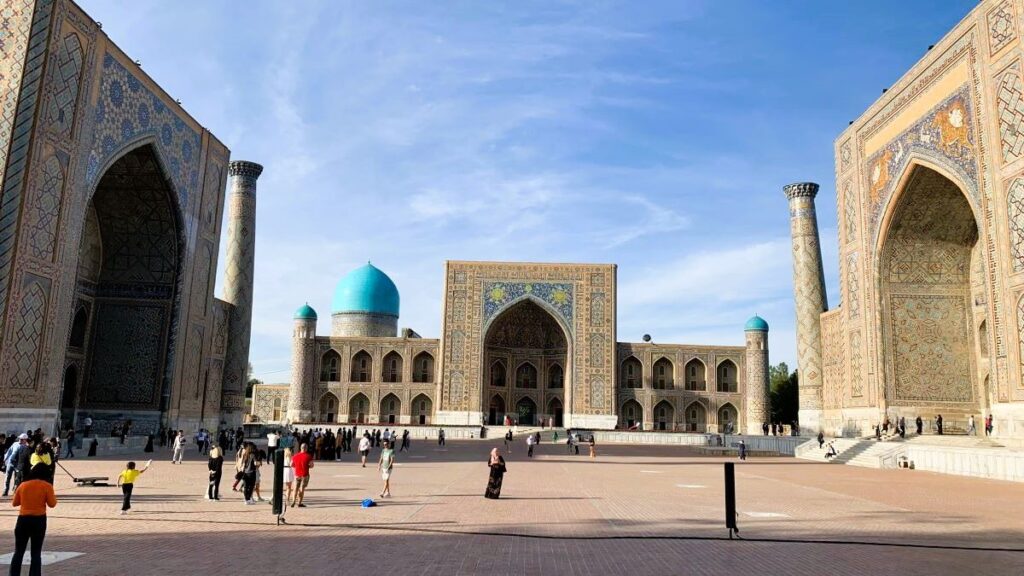
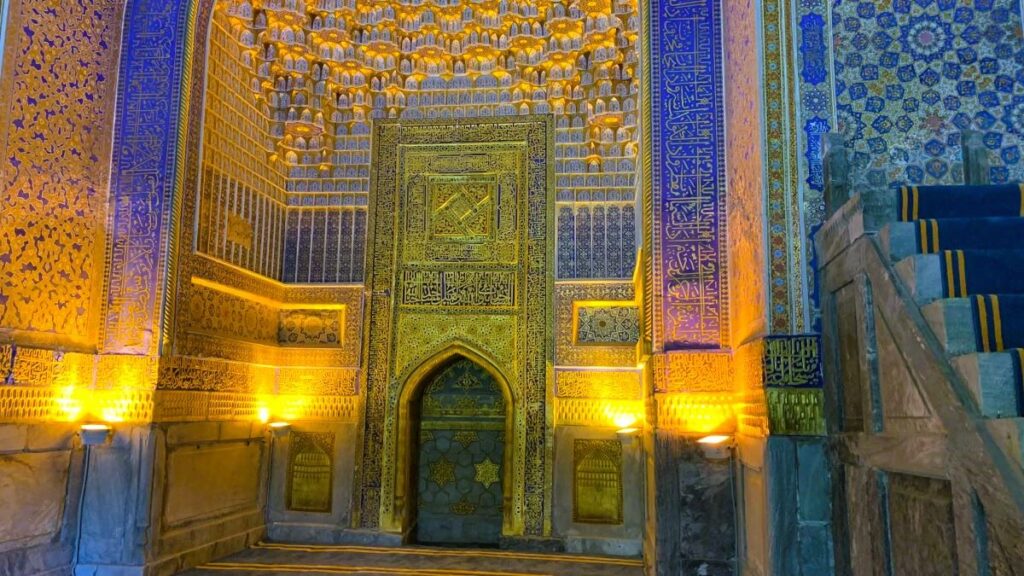
The intricate geometric patterns and symmetrical designs seen here stand as hallmarks of Timurid architecture. Not only does it captivate visitors today, but it also represents centuries of Persian-influenced Islamic art.
For a deep dive into the history of Registan Square, visit Samarkand’s Registan Square.
2. Gur-e-Amir Mausoleum: Resting Place of a Conqueror
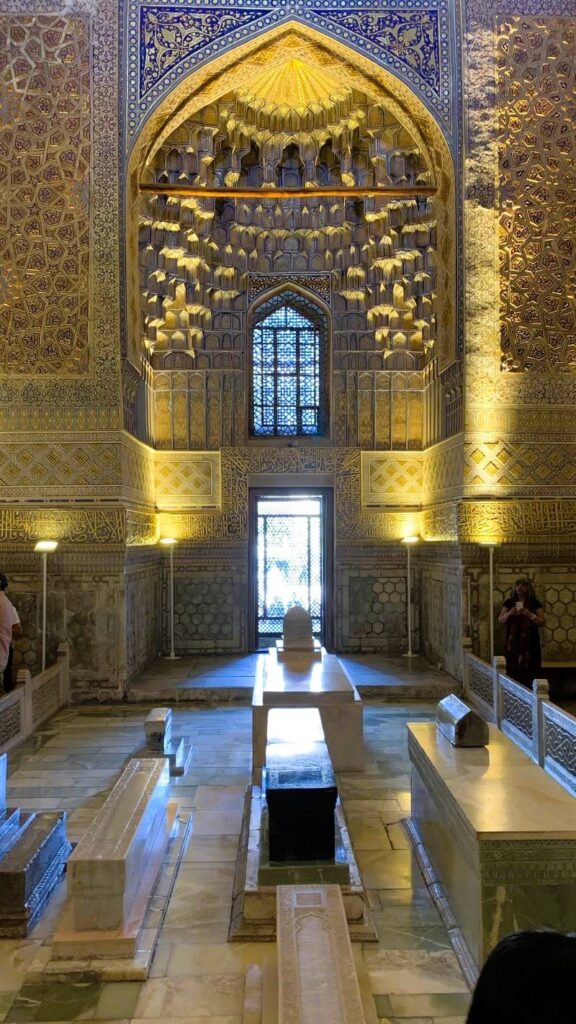
Gur-e-Amir, the final resting place of Timur (Tamerlane), is a wonder of symmetry and beauty. The mausoleum’s ribbed turquoise dome and octagonal chamber capture the essence of Timurid architecture. It was built in the early 15th century and later became a model for Mughal architecture, influencing landmarks like the Taj Mahal.
Timur’s tomb, flanked by the graves of his sons and grandsons, carries immense spiritual and historical significance. The intricate work of Persian tile artistry adorning the walls and the inscriptions highlighting celestial themes make this mausoleum a site of wonder.
Learn more about this iconic site at the Gur-e-Amir Mausoleum.
3. Shah-i-Zinda Necropolis: The Living King’s Eternal Rest
Shah-i-Zinda, translating to “The Living King,” is a necropolis like no other. It is home to a series of intricately designed tombs, believed to house Qutham ibn Abbas, a cousin of the Prophet Muhammad.
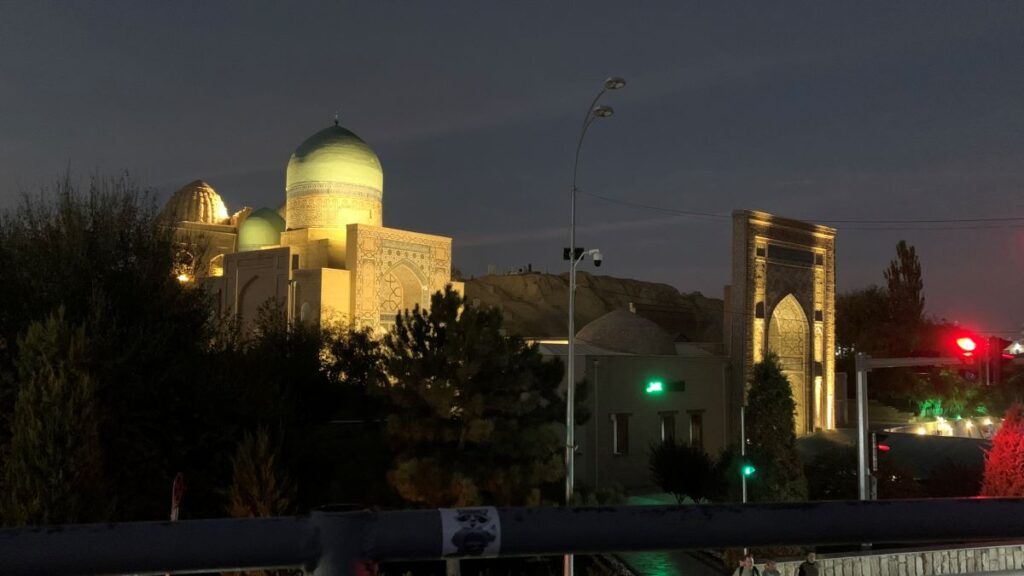
This site has been a pilgrimage destination for centuries, a spiritual sanctuary that continues to draw visitors from around the world.
Walking through the avenue of mausoleums feels like stepping into history itself. The stunning tilework, featuring floral and calligraphic motifs, leaves one in awe of the skills of 11th–15th century artisans.
For more details, check Shah-i Zinda.
4. Bibi-Khanym Mosque: A Monument Restored
Once one of the largest mosques in the world, the Bibi-Khanym Mosque stands as a remarkable testament to Timur’s ambitious vision. Erected in the 15th century, this massive structure was a symbol of Samarkand’s prominence.
Though time and earthquakes inflicted damage, restoration efforts in recent decades have brought back much of its former glory.
Its grand entrance, flanked by towering minarets, and the intricate mihrab inside offer glimpses of its original splendor. Restoration has been a topic of debate, but it undeniably preserves this critical piece of history.
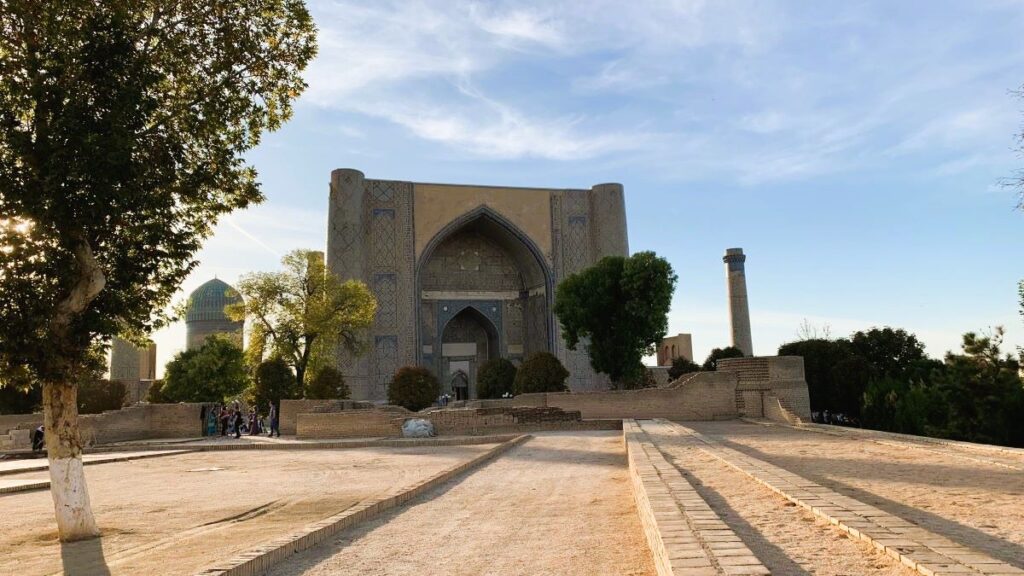
Discover the mosque’s dynamic past at Bibi-Khanym Mosque.
5. Hazrat Khizr Mosque: Samarkand’s Gateway

The Hazrat Khizr Mosque, perched on a hill overlooking the settlement, is among Samarkand’s oldest religious structures. Originally built in the 8th century following the Arab conquest, it symbolizes the city’s Islamic foundations. Its pink-domed roof and elegant wooden carvings create a timeless aesthetic.
Named after the prophet Khizr, this mosque remains a revered site for worship and a favored spot for panoramic views of the city.
For additional insights, explore Hazrat Khizr Mosque.
6. Siyob Bazaar: A Culinary and Cultural Feast
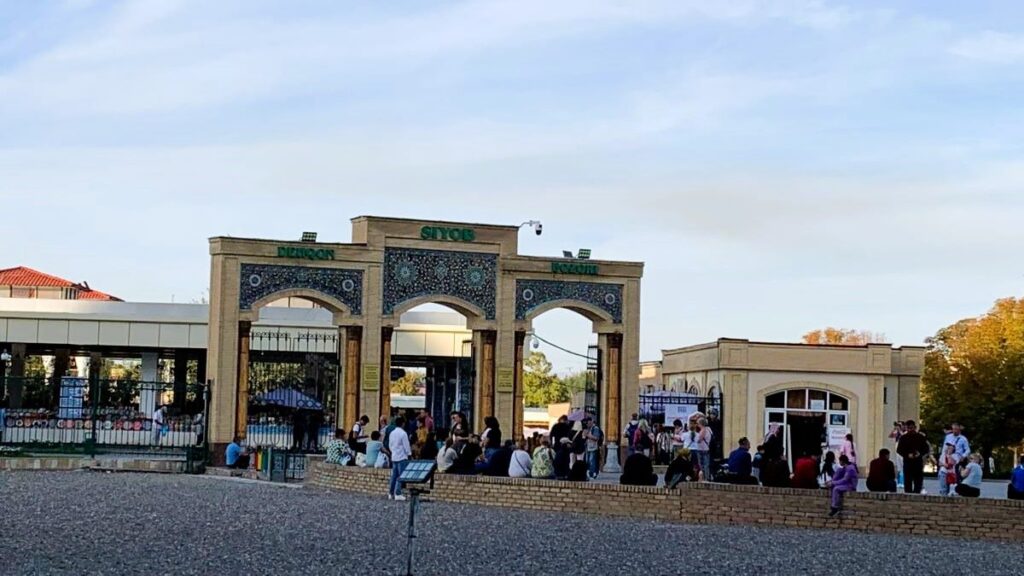
In your list of things to do in Samarkand you cannot leave out the bustling Siyob Bazaar. This vibrant market is a treasure trove of sights, smells, and flavors.
Vendors sell everything from fresh produce and exotic spices to Uzbekistan’s delectable sweets and Uzbekistan made clothes. Sampling “non” (Uzbek bread) or dried fruits is a sensory delight.
For an authentic shopping experience, it’s hard to beat Siyob Bazaar.
Best Time to Visit Samarkand
Timing your visit to Samarkand can make all the difference in experiencing the city’s vibrant cultural atmosphere and stunning architectural beauty.
Thanks to its location in Central Asia, the city boasts a continental climate, with distinct seasonal variations. This means finding the perfect balance of comfortable weather and cultural events is key to a memorable stay.
Spring and Autumn Highlights
Spring (April to May) and autumn (September to early November) are widely considered the best times to visit Samarkand. During these months, the weather is mild, with daytime temperatures ranging between 57°F and 86°F. The cool but sunny conditions are ideal for walking through historic sites such as Registan Square and the Shah-i-Zinda Necropolis without the stifling heat of the summer months.
Spring brings blooming gardens and a sense of renewal across the city, making it the perfect season to stroll through Samarkand’s lush parks and bazaars. The temperatures are pleasant, and the city radiates life, with locals and tourists alike enjoying outdoor activities.
Autumn, on the other hand, features crisp air and a golden hue that blankets the city. September to October is particularly appealing because the summer heat has subsided, leaving behind near-perfect weather for exploring.
The Siyob Bazaar comes alive with fresh harvests of produce, including Samarkand’s famed sweet melons and pomegranates.
Another advantage of visiting during these seasons is the chance to experience local festivals.
In spring, Navruz (the Persian New Year) is celebrated with traditional dances, music, and feasts. This ancient holiday marks the beginning of the farming year and is deeply rooted in the region’s heritage.
Similarly, autumn often features cultural showcases of art and traditional crafts, offering visitors a window into Samarkand’s rich history.
For more details on visiting during these optimal seasons, check out Best Time to Visit Uzbekistan.
By aligning your trip with these months, you’ll enjoy not only pleasant weather but also a dynamic cultural scene that brings Samarkand’s storied history to life.
Navigating Samarkand
From high-tech tram systems to walking-friendly streets, finding your way around this Silk Road gem can be quite effortless. Here’s how.
Transportation Options
Getting around Samarkand offers a mix of convenience and adventure. Travelers can choose from several transportation options depending on their comfort and budget.
- Trams and Public Buses: The city operates an efficient tram and bus system that connects key areas. Trams are modern and offer a seamless way to access historical landmarks like Registan Square. Public buses are slightly more budget-friendly but may require familiarity with local routes. Samarkand’s public transit guide can help first-time visitors plan their trips effortlessly.
- Taxis and Ridesharing: Most of the time they work well. Taxis remain a popular choice for getting around. They are affordable, but make sure to negotiate the fare upfront or use a metered taxi. Ridesharing apps like Yandex are also available and generally offer fixed pricing with less hassle. But sometimes the taxi drivers are from small villages, and at times have a hard time reading the GPS and figuring our routes that could cause some frustration. But with some patience one can manage just fine.
- Shared Taxis and Trains: If you’re travelling to nearby cities like Tashkent or Bukhara, shared taxis stand as an inexpensive option. They leave from specific hubs, such as the one near the Ulugh Beg Observatory. But I would recommend taking the train. The trains are comfortable, fast and efficient in Uzbekistan.
- Walking Routes: Certain neighborhoods are compact and best explored on foot. Registan Square and Shah-i-Zinda are pedestrian-friendly, with cobblestone paths letting you soak in the history and architecture at a leisurely pace. Sturdy shoes are recommended, as some areas can be uneven.
The city’s transportation system is straightforward with a bit of planning. Whether you’re hopping on a tram, sharing a taxi, or exploring on foot, Samarkand makes it easy to get where you want to go.
Best Neighborhoods to Stay In: Recommend areas based on proximity to attractions
Where you stay in Samarkand can shape your experience. The city boasts neighborhoods that cater to different styles of travel, from history buffs to those seeking luxury or budget accommodations.
- City Center: The city center, particularly around Registan Square, is ideal for first-time visitors. Staying here offers close proximity to the main attractions, including Gur-e-Amir Mausoleum and Bibi-Khanym Mosque. Boutique hotels like L’Argamak provide a blend of comfort and a stunning view, as noted by Caravanistan’s accommodations guide.
- Konigil Massivi Area: For a quieter and more affordable experience, the Konigil Massivi area is a solid choice. Boutique guesthouses here combine local charm with lower prices, while still being a short drive from the main city highlights. This area offers a more laid-back experience.
- European Quarter (also known as Russian Quarter): The European quarter caters to those who prefer modern amenities and international brands. Hotels like the Hilton Garden Inn, located slightly farther from historical landmarks, provide luxury stays within a tranquil environment. Tips on options in this area are discussed in Expedia’s neighborhood guide.
Where We Stayed
We stayed in the old town area. The hotel that we stayed at is called Khan Hotel, which is located right across from Shah-I-Zinda complex. It is also within walking distance of all the main Samarkand attractions.
No matter where you stay, you’ll find Samarkand is designed to accommodate diverse preferences.
Local Cuisine to Try
Exploring Samarkand goes beyond its historical monuments—you have to taste the local flavors that have defined its culinary identity for centuries. Here’s what you shouldn’t miss:
Plov (Pilaf): The National Dish of Uzbekistan
Plov isn’t just a dish—it’s a cornerstone of Uzbek culture, often served at weddings, celebrations, and even daily meals.
This hearty mix of rice, lamb, carrots, onions, and an array of aromatic spices is cooked to perfection in a single pot. What makes Plov stand out is the method: layers of ingredients simmer together until every bite is infused with rich, meaty flavors. Be aware that it is quite greasy.
In Samarkand, Plov enjoys its own local twist. The Samarkand variation features firmer rice grains and often has a slightly sweeter taste due to the use of raisins or dried fruits.
Where can you find the best? The Central Asian Plov Center, though located in Tashkent, is highly recommended for authentic flavors (Plov Center Reviews). Closer to Samarkand, many family-run teahouses in the Siyob Bazaar prepare fresh Plov daily. Locals will testify that the midday servings are unbeatable—just follow the intoxicating scent of sizzling lamb and spices!
Samsa and Manti: Iconic Uzbek Pastries
Samsa and Manti are must-try staples of Central Asian street food, both offering a different take on pastry-wrapped comfort food.
- Samsa: Think of Samsa as a cousin to the savory hand pie. These flaky, triangular pastries are stuffed with spiced minced meat, onions, and sometimes pumpkin. Cooked traditionally in clay ovens called “tandoors,” Samsas emerge with a crispy golden shell and a soft, juicy filling inside. They’re incredibly popular as a street snack or a quick meal on the go. At local markets or bakeries, Samsa is a daily ritual for many, with prominent spots near Siyob Bazaar. For an insightful look into Samsa’s origins and appeal, check out Uzbek Samsa History.
- Manti: These are large, steamed dumplings usually stuffed with lamb or beef and seasoned with onions and black pepper. Manti is often lighter than Samsa, but equally satisfying. Served with a dollop of sour cream or a sprinkle of sumac, they offer an explosion of flavor with every bite. Manti is best experienced at sit-down eateries, where portions are generous, and they’re often paired with traditional herbal teas. The history of Manti is well-documented as a dish that traveled along the Silk Road, embodying the shared culinary DNA of Central Asia (Learn more about Manti).
Both pastries share deep ties to Samarkand’s multicultural past and are a culinary connection to the days when traders exchanged recipes as often as goods. Wherever you stop for these local favorites, rest assured you’re tasting a piece of history.
Cultural Etiquette for Visitors
When visiting Samarkand, respecting the local customs significantly enriches the travel experience.
As a city with deep Islamic roots and a crossroads of diverse cultures, small gestures of cultural awareness can leave lasting impressions and foster genuine connections with locals.
Here’s what we need to know about dressing and behaving respectfully in this wonderful city.
Dress Code and Behavior: Guidelines for Appropriate Attire and Manners
Understanding how to dress and behave in Samarkand is crucial for showing respect to local traditions.
While Uzbekistan tends to be more liberal compared to some other predominantly Muslim countries, modesty in clothing and demeanor is appreciated, especially when visiting religious landmarks.
Dressing Modestly
- Recommended Attire for Men: Men can wear short-sleeved shirts and pants, but shorts are uncommon outside tourist-heavy areas. Long trousers are the preferred choice for blending in.
- Recommended Attire for Women: Women should opt for clothing that covers their shoulders, cleavage, and knees. Maxi dresses or skirts paired with loose-fitting blouses work well. A scarf may also be useful for visiting mosques or conservative neighborhoods.
In urban centers like Samarkand, clothing norms are more relaxed, with locals adopting modern styles. However, when visiting religious sites such as mosques or the Shah-i-Zinda Necropolis, stricter modesty is expected.
For guidance on specific recommendations, you can explore an extensive cultural overview at Cultural etiquette to take into account to travel to Uzbekistan.
Essential Behavioral Etiquette
- Greetings: Handshakes are customary among men, but women often greet with a nod or hand over their chest. Respect each individual’s comfort level and follow their lead.
- Removing Shoes: Always remove your shoes before entering someone’s home or a religious site. This shows respect for cleanliness and sacred spaces.
- Respect for Elders: Elders are held in high regard. Offer your seat on public transport and avoid interrupting or speaking over them. Small acts of deference, like letting them enter first, are deeply appreciated.
- Photography Etiquette: It’s respectful to ask for permission before photographing locals, particularly in traditional dress or at holy sites.
We’ve found that even small gestures—like a warm smile or learning a few Uzbek phrases—go a long way in building rapport with locals. For further tips on respectful behavior while traveling in Uzbekistan, check out Instruction for tourists in Uzbekistan – Etiquette.
By dressing modestly and acting considerately, we honor Samarkand’s traditions, making our visit harmonious and meaningful.
Can You Drink Alcohol in Samarkand?
Yes. You can drink alcohol everywhere in Uzbekistan.
Here’s a surprise for many people – despite its predominantly Muslim population, Uzbekistan has a thriving market for alcoholic beverages, deeply rooted in its historical and cultural background.
Currency Used In Uzbekistan
The official currency used in Samarkand, and throughout Uzbekistan, is the Uzbekistani Som (UZS). While US dollars and Euros are accepted at high-end hotels, tourist-oriented shops, and certain businesses, most local transactions require Uzbekistani Som.
It’s advisable to exchange foreign currency at official exchange offices or banks upon arrival. Credit cards, especially Visa and Mastercard, are becoming more widely accepted in Samarkand, particularly in upscale hotels, restaurants, and larger stores. However, many smaller establishments, bazaars, and local eateries operate on a cash-only basis, so it’s essential to carry sufficient cash in the local currency. ATMs are available in major areas, but access can be limited outside tourist zones, so plan accordingly.
Conclusion
Visiting Samarkand is quite an experience. It is a city that has an extraordinary blend of history, culture, and timeless beauty. Its position as a jewel of the Silk Road makes it an unmissable destination for travelers seeking a unique and authentic experience.
Whether exploring the grandeur of Registan Square, savoring the delicate flavors of local Plov, or wandering through the bazaars, the city offers something for everyone. As you can see there are many reasons why you should be visiting Samarkand. Hope this blog was helpful. Would love to hear from you in the comments below.
Other Posts On Uzbekistan:
Other Posts That You Might Also Like:
-
The Best Florence 3-Day Itinerary For First Timers (Landmarks, Views, And Food)
Planning a trip to Florence? Awesome! You’re in for a treat! Florence packs centuries of art, culture, and history into streets that are super easy to wander on foot. This Florence 3 day itinerary is built for first-time visitors who want the big sights, plus time to eat well, shop a little, and wander without…
-
Your Ultimate 3-Day Itinerary in Rome (First-Time Visit Guide)
Arriving in Rome, the Eternal City, for the first time feels like stepping into a living history book. I’m not kidding. Everywhere you turn you find ancient ruins, renaissance churches, and fountains, sometimes sharing the same charming streets. The city buzzes with energy, from the scooters zipping by to the lively piazzas filled with people…
-
The Ultimate Italy Travel Guide for First‑Time Visitors (Simple, Honest Tips)
Italy is one of those places that lives in your head long before you land. Ancient ruins, quiet churches, busy piazzas, long dinners, and trains that carry you from city to city like scenes in a film. When friends ask me where they should go on their first big trip to Europe, Italy is usually…
-
Travel Chiang Mai, Thailand: A Calm Base for Temples, Markets, and Food
Your Ultimate Travel Chiang Mai Thailand Guide Chiang Mai sits in a green valley in northern Thailand, ringed by low mountains and crowned by temples that have been there for centuries. Key Takeaways: This Travel Guide to Chiang Mai, Thailand also shares a simple 3-day plan you can follow without stress. The Old City, with…
-
Lake Bled Day Trip: The Perfect First-Time Adventure from Ljubljana
Welcome! If you’re spending time in Ljubljana and want to experience Slovenia’s most magical landscapes, a Lake Bled day trip from Ljubljana is an easy choice. With its glacial blue water, Lake Bled Island at its center, and Bled Castle perched high on the cliffs, this spot looks straight out of a fairytale—no need for…
-
Best Things to Do in Ljubljana, Slovenia (First-Time Visitor’s Guide)
Welcome! Thank you for visiting my blog about the best things to do in Ljubljana! In this guide I’ll share my own favorite spots and handy tips, best places to eat and some local insights you might not find elsewhere. Ljubljana, the charming capital of Slovenia, is stunning! The architecture is breathtaking! I promise you,…

